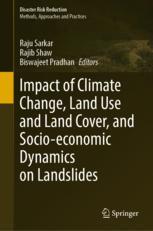This book discusses the impact of
climate change, land use and land cover, and socio-economic dynamics on
landslides in Asian countries. Scholars recently have brought about a shift in
their focus regarding triggering factors for landslides, from rainfall or
earthquake to claiming rapid urbanization, extreme population pressure,
improper land use planning, illegal hill cutting for settlements and
indiscriminate deforestation. This suggests that the occurrence or
probabilities of landslides are shaped by both climate-related and
non-climate-related anthropogenic factors. Among these issues, land use and
land cover change or improper land use planning is one of the key factors.
Further climate change shapes the rainfall pattern and intensity in different
parts of the world, and consequently rainfall-triggered landslides have
increased. These changes cause socio-economic changes. Conversely,
socio-economic and lifestyle changes enhance inappropriate land use and climate
change. All these changes in land use, climate and socio-economic aspects are
dynamics in nature and shape landslide risks in Asian countries, where they are
given serious attention by governments, disaster management professionals,
researchers and academicians.
This book comprises 21 chapters divided
into three major sections highlighting the effect of climate change on
landslide incidence with the influence on vegetation and socio-economic
aspects. The sections address how climate change and extreme events have
triggered landslides. The advances in geospatial techniques with the focus on
land use and land cover change along with the effect on socio-economic aspects
are also explored.





